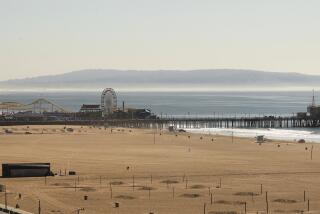Scaled-Down Airport Complex Approved 4-3 : Development: The Santa Monica City Council spent a contentious five hours debating the merits of the commercial and retail office project before the mayor cast the deciding vote.
- Share via
The Santa Monica City Council approved plans for a controversial office complex at Santa Monica Airport early Wednesday, despite an hours-long effort by one member to defeat the project with a point-by-point challenge of traffic and revenue information. Tempers were flaring after midnight when the council voted 4 to 3 to approve a 822,000-square-foot version of the originally proposed Santa Monica Common commercial and retail office complex.
The developer, Reliance Development Group, had agreed to accept the scaled-back version of the project, and said the smaller version of the project would have little or no impact on surrounding areas. Reliance was selected by the city in 1987 to develop the 37.56 acres of city-owned property at Bundy Drive and Airport Avenue, at the southeast corner of the airport.
In reducing the original 1.3-million-square-foot proposal, the council hoped to satisfy Reliance, which had threatened to back out if the city cut the project to less than 822,000 square feet, and also soothe angry nearby residents, who said the sprawling complex would wreak havoc on traffic in their neighborhoods.
“In my judgment, this project will help this community in a dramatic fashion with many of its major concerns,” said Mayor Dennis Zane shortly before providing the key vote.
Zane argued that money received from the project--estimated as high as $27 million over the next 10 years from lease payments and taxes--could be used to bolster sagging social, education, and parks programs in the city.
Though several of the council members appeared to have made a decision on the fate of Santa Monica Common early in the five-hour hearing, some members posed a long series of highly detailed questions to city staff and the developer in an effort to sway members against the project.
Councilman Ken Genser doggedly pursued supporters of the project with inquiries into how traffic studies were made, whether the description of the smaller project as having “no impact” on surrounding areas was accurate, and whether projected revenues from the project were overly optimistic.
At one point, the council was nearly forced to adjourn when it was unable to pass a motion to extend the meeting beyond 11 p.m. because Genser would not agree to halt his questions. Councilman Herbert Katz, who with Mayor Pro Tempore David Finkel sided with Genser against the project, objected to Genser’s persistent questions on minute details, and said he would not vote to extend the meeting as required unless questions were halted. Several council members accused Genser of conducting a filibuster but they finally were able to vote to continue the meeting and end questions.
Though clearly annoyed, Genser stopped his questions after explaining why his interrogation had been so exhaustive:
“I can’t accept a (project) analysis that says the sky is red when I know it’s blue. I just think it is very unwise of us to dispose of open space like this for a period probably longer than our lifetime,” Genser said.
The decision brought to a formal end the fight over what to do with the city-owned tract at the airport’s southeast corner.
Opponents, many from Mar Vista and other neighborhoods of Los Angeles, had swarmed a series of public hearings before the council and the Santa Monica Planning Commission in recent weeks to loudly protest the project. Most objections revolved around traffic that would be generated by the complex.
Los Angeles residents complained that because the development is blocked off from the rest of Santa Monica by the airport, all of the traffic from Santa Monica Common would pass through their neighborhoods, even though Los Angeles would receive none of the financial benefits from the project. Santa Monica residents protested that the project would produce traffic jams and construction dust, and said the property would better serve the city as a park.
Though public comment on the project had been closed by the council after a special hearing Oct. 3, about 30 vocal opponents awaited the council’s decision with cheers for the no votes and jeers for the ayes.
Los Angeles resident William Scheding, who jumped up and shouted “coward!” when Zane cast the deciding vote, predicted that the decision would come back to haunt Santa Monica.
“All the negative effects are in Los Angeles,” Scheding said. “All the positive effects are in Santa Monica. That’s not a good-neighbor policy. . . . I think the city of Santa Monica will get burnt by this project in the end.” Scheding said several lawsuits against the project are in the works.
Though an environmental impact report estimated that as many as 12,000 daily car trips would flow onto Bundy Drive, both city staff and developer’s consultants argued that improvements by Santa Monica at a number of intersections and the widening of Centinela Avenue south of the airport by the city of Los Angeles would reduce the impacts of that traffic to zero.
NEXT STEP The City Council will formally authorize the project with ordinances in the next month. Lawsuits to block construction are certain to follow. If they are resolved, construction could begin in 1991.
More to Read
Sign up for Essential California
The most important California stories and recommendations in your inbox every morning.
You may occasionally receive promotional content from the Los Angeles Times.













